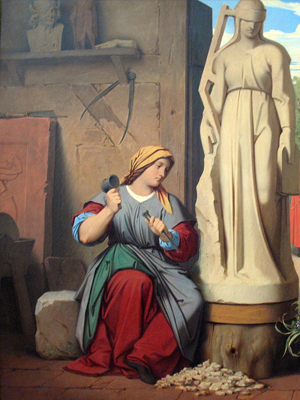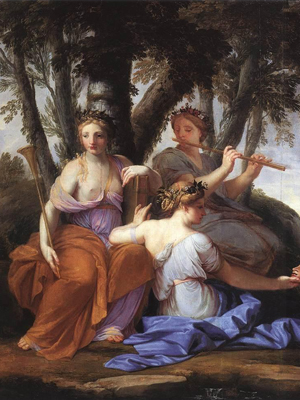Masonic Articles and Essays
The Masonic Muse: Where Does Inspiration Come From?
Very Illus ..... Bro... Pamela McDown 33°
Date Published:
10/11/2023
The Muses of Greek mythology and legend are those beings that exist beyond the material plane and communicate ideas and inspiration from planes beyond our perception. How does Freemasonry draw us into communication with them?
 Inspiration is a mystical, magical thing that grasps the artist, the poet, the inventor, the freemason and even the scientist. Throughout history, artists, musicians, poets, and playwrights have professed that their creative works did not originate solely from their own abilities or genius, but rather from a force or divinity transcending them. They felt inspired, becoming the vessel through which something truly beautiful could manifest in the world.
Inspiration is a mystical, magical thing that grasps the artist, the poet, the inventor, the freemason and even the scientist. Throughout history, artists, musicians, poets, and playwrights have professed that their creative works did not originate solely from their own abilities or genius, but rather from a force or divinity transcending them. They felt inspired, becoming the vessel through which something truly beautiful could manifest in the world.
I have always wondered what inspires creativity. Why does one person excel as a physician, another as a novelist, and yet a third as a legislator? Why do some fortunate people seem overly endowed with an abundance of creativity – this most precious of gifts – and others with little or none at all? What inspires the freemason?
Freemasons are asked at the opening of every Lodge meeting to meditate on the Good, the True and the Beautiful. Brother C. Jinarajadasa wrote that finding the beautiful is a factor in the soul’s evolution. Poetry, sculpture, song, dance, architecture, music, masonic ritual, all these aspects of life are so many magic doors which open new regions of life. He says that this “Beautiful” is in every one of us and when we realize this, we are going to realize that this is the greatest power we have. When this greatest power which is in us is realized then we will truly be the builders of a better world.
But we’re not there yet. Unfortunately, beauty and inspiration have fallen on hard times. In our materialistic modern world, we have little sense of where true genius comes from. But it wasn’t always so. What can we learn from the Ancient Greeks?
The Nine Muses in Greek Mythology
In Greek mythology, the muses held a significant role as wellsprings of inspiration. They oversaw both the realms of arts and sciences, frequently offering assistance and direction to individuals in their pursuit of extraordinary ideas and breakthroughs. It was believed that the muses had the ability to convey inspirations from higher realms, granting us glimpses beyond our everyday existence. In doing so, they established channels of communication that spanned the divides within our mental and emotional landscapes.
Residing on Mount Helicon, the nine muses frequently kept company with the god Apollo, whose realm often intersected with theirs. He governed domains like Music, Light, Eloquence, Poetry, and the Sun. Each of the nine muses had a name and a field of service:
1. Calliope inspired epic poetry.
2. Erato inspired love poetry.
3. Euterpe inspired lyric poetry.
4. Melpomene inspired tragedy.
5. Thalia inspired comedy.
6. Clio inspired history.
7. Urania inspired astronomy.
8. Polyhymnia inspired sacred songs.
9. Terpsichore inspired dance.
Muses were important to the Greeks, no doubt, but the world has changed a lot since ancient times. With so many arts and sciences nowadays, the nine muses of yore are not enough. This led me to think about the muse(s) associated with the Art of Freemasonry. Is there one or more? How is a Freemason creatively inspired?
The Masonic Devas
 In the book, “At the Sign of the Square and Compasses”, Brother Geoffrey Hodson writes about the existence of Masonic Devas. When I thought about it, these devas could also be considered muses by a broader definition. Brother Hodson claims that during Masonic Ceremonies there is a deva attached to each of the various offices and a number of others that move freely about the Temple and hover in the air overhead. They cooperate with the brethren in all the work and bring an additional measure of power and beauty to the workings.
In the book, “At the Sign of the Square and Compasses”, Brother Geoffrey Hodson writes about the existence of Masonic Devas. When I thought about it, these devas could also be considered muses by a broader definition. Brother Hodson claims that during Masonic Ceremonies there is a deva attached to each of the various offices and a number of others that move freely about the Temple and hover in the air overhead. They cooperate with the brethren in all the work and bring an additional measure of power and beauty to the workings.
For example, he says the Deacons who guide the candidates in the Lodge receive inspiration from a deva who appears to be a sylph. During the Ceremony, the Deacons move beautifully through the Lodge as glorious radiant beings. Through their vehicles, they receive energy and vitality which is liberated into the Lodge and into the candidate.
Brother Hodson writes:
“Streams of force are poured into the candidate’s aura which is made to glow with a white radiance and also to expand in size. The astral body is purified, refined, and generally raised in tone and vibratory rate.”
Here are three conclusions he gives about the power of Devic inspiration in Masonic Ceremonies.
- Quickens the evolution of the candidate, of all Masons, of the consciousness within the matter of which the temple and its equipment is built, and in lesser degree of all consciousness and matter within the range of the influences radiated from the ceremony.
- Radiates mighty and uplifting forces into the world at large, affection in varying degrees individuals, nations, and all other created beings.
- Develops in Masons as also in the Deva participants the technique and powers of intercommunion and co-operation.
Being a highly trained clairvoyant, Brother Hodson used his gift to document many clairvoyant observations in the Lodge of things invisible to most.
In closing, I’d like to believe that muses really exist, but in a broader sense. Muses are said to be higher beings that communicate with us when we are in a lofty state of consciousness, in a heroic mood, and when we are daring and courageous. They contact us through our moments of prayer, meditation, aspiration, and intense labor. Great artists feel their presence. Their presence charges them, opens their consciousness, invigorates them, and electrifies all their creative centers. Their presence encourages the artist and freemason alike, and they feel that they are not alone in their creative labor.
Overall, we can conclude that over time, the muses, and devas of creative workers have inspired magnificent discoveries and creations. By doing so, they have encouraged delight in human experience, creativity, and thought. Masonry illustrates the teaching that a potential Jewel lies within the stone; yet though this Jewel may be perceived from many angles and perspectives, it will always reveal Beauty.
Is everyone capable of finding their muse and expressing their innate creativity in some way? Most of our population believe that some people are creative, and others are not. I believe that everyone is a creative worker. In fact, we are each creating this very moment.
More Masonic Articles
Explore articles and essays written by Freemasons about Freemasonry.
Read More
Membership
Interested in becoming a member of the worlds oldest Fraternal organization?
Read More